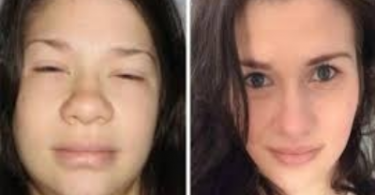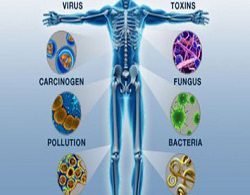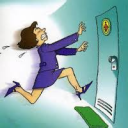Introduction
Pompholyxa, also known as dishydroticb eczema, is a skin condition especially affecting hands (cheiropompholyx) and feet (pedopompholyx), characterised by a sudden onset of many deep seated, pruritic, clear vesicles. Recurrence is common and many cases become chronic later with scaling, fissures and lichenification1.
The first (acute) stages show tiny blisters (vesicles) deep in the skin of palms, fingers and toes. The blisters are small (less than 3mm in size) and intensely itchy or have a burning feeling along with a tendency to burst or break when triggered by an external force or a substance that is most likely to cause infection and irritation such as soap, water, etc. Any kind of scratching of the blisters may cause them to turn red and swell and form crust and cracks. With recurrence, the tiny blisters acquire the tendency to merge together to give rise to blisters which are obviously greater in shape and size. The latter and more chronic stages show more peeling, cracking and crusting. Severe pompholyx around the nail folds may cause nail dystrophy, resulting in irregular ridges and chronic paronychia2.
One of the earliest description of this clinical condition can be found in medical texts of China since the times of Ming dynasty (14th century) under various nomenclatures like River snail vesicle, Ant nest etc.3
The exact cause of pompholyx is not known. However, possible trigger factors4 are:
- Excessive sweating during periods of stress and anxiety
- Fungal infections like Athlete’s foot
- Prolonged exposure to strong sunlight with dehydration
- Allergic agents such as carbonated and alcoholic beverages, food items high in nickel and caffeine content, dairy products- butter and cheese, cocoa, chocolate, soy, etc; allergies may be caused by contact with Cr (6+) compounds such as Potassium dichromate and other leather preservatives; dust mite allergies, antibacterial soaps, deodorants and fragrances, detergents etc.; contact with fresh meat & fruit juices, chopping fresh vegetables etc.
- Dermatitis of all kinds such as Seborrheic and Atopic may also be the reason behind the occurrence of pompholyx.
- Immune problems such as Ulcerative colitis, Inflammatory Bowel Disease, and Crohn’s Disease are also known to exacerbate pompholyx.
- Differential Diagnosis5 must include
- Pustular Psoriasis
- Fungal infection
- Bacterial infection/bullous impetigo
- Dishydrosiform bullous pemphigoid
- Bullous pemphigoid
- Contact Dermatitis
- Pityriasis rubra pilaris
- Epidermolysis bullosa
- Erythema multiforme
- Contact urticaria syndrome.
- Fixed drug eruptions.
- Herpes Simplex
Bandages, plasters or other types of skin-tapes may be irritating to affected areas by encouraging maceration and should be avoided as the skin needs to breathe. Washing with hot water and too frequent use of soaps should be avoided. Gloves should be used while washing clothes, using detergents, hair colours and other chemicals.
So far there is no published research study showing efficacy of homoeopathic treatment in case of Pompholyx. However, few case studies6 have been published showing successful treatment with homoeopathy.
Case Study
A 65 years old lady was seen on 21/7/07. She had brown eyes, coloured hair, (baggy) swelling below eyes; average height, heavier built; she was noticed sighing involuntarily.
Present Complaints
She complained of recurrent episodes of itchy vesicles on her b/l fingers since four years; scratching them led to swelling, clear watery discharge and painful cracks, which hampered her day to day activities. Dermatologists had prescribed to her some anti allergies and topical ointments Cotaryl and Zincoderm GM.
She was also noticing hypo-pigmented lesions on b/l legs– shin region since three years.
She was also suffering with hypertension for about two years for which she was under daily allopathic medication.
On and off cervical spondylosis troubled her for which she used to undergo physiotherapy.
Her routine blood work in the month of June 2007 had revealed Hb 11.5 gm% hence she was on Iron supplementation.
Past Illnesses
- Chicken pox in childhood
- Measles in college time
- Underwent surgery for piles 12 years back (felt lumps without much bleeding)
- H/O eruptions with itching b/l legs > ointment few years back
Personal History
- Diet: Non vegetarian
- Marital status: Widow
- G2P2A0
Family history
- Father: HT, DM
- Mother: OA
- Brother: Heart affections, HT
Generals
- Thirst: 3-4 litres/ day
- Desire: Non veg: fish++, egg++; Aerated drinks (Sprite) ++: salty++, chocolates+++, milk++, butter milk++
- Bowels: Constipation, skips days (needs isabgol (laxative) with milk at night)
- Sleep: Sometimes disturbed, breaks in between and then she is unable to sleep again (since her husband’s death); uses larpose (narcotic drug) on & off; mostly on sides
- Perspiration: especially on scalp, during sleep (prior to her husband’s death); decreased thereafter
- Thermal Reaction: loves winters
- Tongue: blackish edges, jerky
- She’s extremely fond of good perfume
Life Space Investigation
She was born in east Bengal and brought up in west Bengal. She had a comfortable life all throughout and travelled much along with her husband after marriage. Both her children were well settled in their careers. Her elder son is not married as he was too busy with career.
Three years back (2004) she lost her eldest brother after severe illness who was father like to her. Her skin troubles started soon after he fell ill and after his death there was a severe aggravation.
Her husband was diagnosed with CA Pancreas in Feb 2005 and he passed away in Sept 2005. She developed high blood pressure and sleep disturbances soon after that.
She has been associated with an NGO which helps the underprivileged people earn a livelihood since last 10 years. Few months back she has severed her association with the NGO as its staff has been misusing the funds.
Though she likes to work/ teach the under-privileged and needy, other times she prefers being alone.
Prescription & Follow up
Rx
Ignatia amara LM 1 OD
07-08-07
Hands better than before but there is swelling and itching on fingers in the morning hours. She has also developed allergic rashes on chin and upper eye-lids. Sleep was somewhat better and she used larpose only twice in between, avoided the other days. Bowels were regular due to laxatives; tried skipping for a few days but it did not work.
Rx
Ignatia amara LM2 OD
03-09-07
Same as last time.
Rx
Ignatia amara LM 3 OD
18-09-07
Sleep was disturbed at 3-3:30 am on most of the days. She was very disturbed (as her late husband’s birthday and anniversary were due).
She was also upset by an argument with her NGO’s previous secretary. Ever since her BP had been high though the allopathic doctor had increased the dosage of her medication. (Blood Pressure was 170/1-4 mmHg)
Cracks with itching appeared on and off. But, she felt there was slight improvement in her skin complaints.
Bowels regular with laxatives.
Observing no change in mood and generalities, the entire case was re-taken and reviewed.
She revealed in re-case taking that she feels like singing whenever there is thunderstorm and lightening.
Rx
Carcinosinum 30/ one dose.
13-11-07
Cracks in fingers were much better- only twice in last 2 months. Itching was there occasionally.
Her sleeping time is now mostly 10 pm to 4-4:30 am with only once or twice need for larpose (narcotic drug).
Blood Pressure was 132/84 mmHg with previous (reduced) dosage of medication.
Bowels are regular without isabgol (laxative) now.
Rx
Sac lac
20-3-08
No more episodes of cracks or itching in last 4 months.
Sleep has improved, from 10 pm to 4-4:30 am without any medication.
Blood pressure has been keeping fine with very light dosage of medicine.
Bowels regular (without laxative).
Skin of legs has normal pigmentation.
Discussion
“This individualising examination of a case of disease, for which I shall only give in this place general directions, of which the practitioner will bear in mind only what is applicable for each individual case, demands of the physician nothing but freedom from prejudice and sound senses, attention in observing and fidelity in tracing the picture of the disease.”7
My initial prescription was fuelled by ‘my prejudice’ when I observed involuntary sighing and heard about the loss of brother and husband in the patient’s history. I committed the mistake of prescribing to Ignatia amara because I forgot to remember that:
- Ignatia amara is not the only remedy having ‘Involuntary sighing’. H.C. Allen’s Keynotes8 mentions Calcarea phosphorica & Lachesis mutus also;
- Ignatia amara is not the only remedy for grief, there are numerous others.
Later, in the course of follow up, I realized that in spite of repetition, there was no definite progress in her disposition & generalities that is to say in her mood, sleep or bowel movements.
Thus a careful ‘unprejudiced’ reconsideration of the case was required and hence it was retaken. During this review, she revealed that she felt like singing whenever she saw thunderstorm and lightening. This reminded me of the symptom mentioned under Carcinosinum, ‘Enjoys watching the thunderstorm9.’ In her case taking she had also revealed that she had a marked craving for chocolates (+++), which is another characteristic feature of the remedy Carcinosinum10.
I also recalled one of the clinical tips given by Prof. L. M. Khan that whenever someone’s spouse suffers/ dies with cancer we must think of the remedy Carcinosinum for him/ her.
Hence, Carcinosinum was prescribed in the case, a single dose of which in the 30th potency was sufficient to set the patient on the path of recovery. The choice of 30th potency was purely empirical.
Conclusion
A homeopathic physician can have an unprejudiced mind only by mastering all the Doctrines of Homeopathy and faithfully adhering to the teachings of Organon. If any physician approaches a patient with bias towards a certain diagnosis or remedy, he ceases to be ‘the physician with a mission’. It is apt to quote here the immortal James Tyler Kent,
It is certain that the true man is one freest from prejudices, one who can listen, who can examine, evidence and who, can meditate.11
Acknowledgement
Dr Saloni Khanna, who helped in writing and editing the case study.
Bibliography
- 1. http://en.wikipedia.org/wiki/Pompholyx as accessed on 27-7-12.
- 2 http://dermnetnz.org/dermatitis/pompholyx.html as accessed on 27-7-12.
- 3 http://www.jcm.co.uk/media/sample_articles/pompholyx.pdf as accessed on 27-7-12.
- 4 http://www.primehealthchannel.com/pompholyx-dyshidrosis-pictures-symptoms-causes-and-treatment.html as accessed on 27-7-12.
- 5 http://www.patient.co.uk/doctor/Pompholyx-(Dyshidrotic-Eczema).htm as accessed on 27-7-12.
- 6 Sharma, RK 2010, ‘Dyshydrotic Eczema Cured with Ranunculus’, Homeopathic Journal, vol. 3, issue11. As accessed on the website
- 7 Hahnemann, S 2008, § 211, Organon of Medicine, reprint edn., B Jain Publishers (P) Ltd, New Delhi, pp. 73.
- 8 Allen, HC 1967, Keynotes and Characteristics with Comparisons of Some of the Leading Remedies of the Materia Medica, Roy Publishing House, Calcutta, pp. 77 & 146.
- 9 Allen, HC 1967, Keynotes and Characteristics with Comparisons of Some of the Leading Remedies of the Materia Medica, Roy Publishing House, Calcutta, pp. 450.
- 10 Vermeulen, F 2001, Concordant Materia Medica, Indian Books & Periodicals Publishers, New Delhi, pp 266.
- 11 Kent, JT 2006, Lectures on Homoeopathic Philosophy, B Jain Publishers (P) Ltd, New Delhi, pp. 162.





